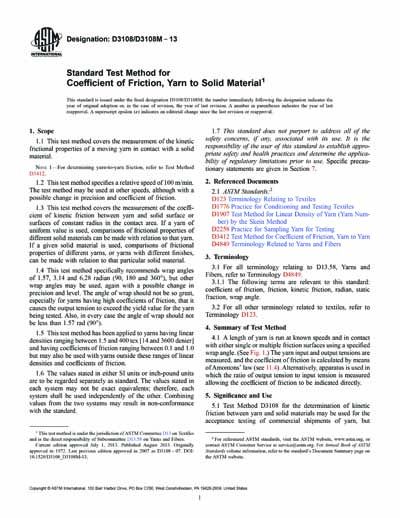Historical
ASTM D3108/D3108M-13
Standard Test Method for Coefficient of Friction, Yarn to Solid Material
1.1 This test method covers the measurement of the kinetic frictional properties of a moving yarn in contact with a solid material.
1.2 This test method specifies a relative speed of 100 m/min. The test method may be used at other speeds, although with a possible change in precision and coefficient of friction.
1.3 This test method covers the measurement of the coefficient of kinetic friction between yarn and solid surface or surfaces of constant radius in the contact area. If a yarn of uniform value is used, comparisons of frictional properties of different solid materials can be made with relation to that yarn. If a given solid material is used, comparisons of frictional properties of different yarns, or yarns with different finishes, can be made with relation to that particular solid material.
1.4 This test method specifically recommends wrap angles of 1.57, 3.14 and 6.28 radian (90, 180 and 360°), but other wrap angles may be used, again with a possible change in precision and level. The angle of wrap should not be so great, especially for yarns having high coefficients of friction, that it causes the output tension to exceed the yield value for the yarn being tested. Also, in every case the angle of wrap should not be less than 1.57 rad (90°).
1.5 This test method has been applied to yarns having linear densities ranging between 1.5 and 400 tex [14 and 3600 denier] and having coefficients of friction ranging between 0.1 and 1.0 but may also be used with yarns outside these ranges of linear densities and coefficients of friction.
1.6 The values stated in either SI units or inch-pound units are to be regarded separately as standard. The values stated in each system may not be exact equivalents; therefore, each system shall be used independently of the other. Combining values from the two systems may result in non-conformance with the standard.
1.7 This standard does not purport to address all of the safety concerns, if any, associated with its use. It is the responsibility of the user of this standard to establish appropriate safety and health practices and determine the applicability of regulatory limitations prior to use. Specific precautionary statements are given in Section 7.
Content Provider
ASTM International [astm]






